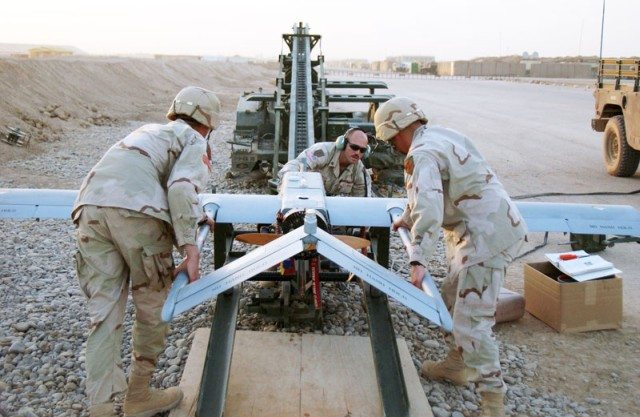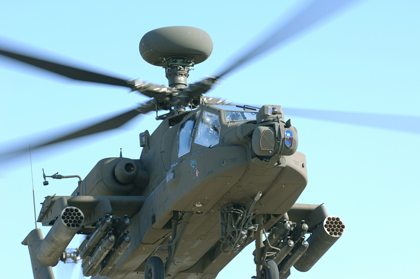An unmanned aircraft system in the Army’s fleet today is defying gravity, soaring ever higher in performance and zooming down on cost.
And, in a budget-conscious Department of Defense, exceeding performance and cost goals are enough to make the RQ-7B Shadow 200 Tactical Unmanned Aerial Vehicle a target for recognition.
Such was the case last fall when Shadow won the prestigious Performance-Based Logistics Award from the Secretary of Defense. According to the award nomination package, the Shadow PBL contract achieved exceptionally high readiness with the system, while simultaneously reducing its costs and improving its reliability.
But such recognition doesn’t mean the Shadow is coasting on its merits. Rather, its government-contractor team is honed in on even better performance and cost savings.
“We’ve taken cost very seriously and we’ve indoctrinated a lot of things into Shadow to bring those costs down. We’ve also decreased incident rates,” Todd Smith, deputy product manager for Shadow, said of the 43 Redstone Arsenal-based employees whose work is centered on product development, sustainment, cost, scheduling, performance and other life cycle management issues pertaining to Shadow.
Described as the “workhorse” of the Army’s unmanned aircraft systems, Shadow has exceeded 600,000 combat hours in Iraq and Afghanistan since it was introduced to the Army fleet in 2003, flying missions for the first time during the U.S. invasion of Iraq. The Army has fielded 98 Shadow systems, and the Marines 11. Its mission in unmanned, over-the-horizon reconnaissance, surveillance and target acquisition has made it a forerunner in providing situational analysis to Soldiers on the battlefield.
Even so, those early Shadow years did present challenges.
“The Shadow has been the Army’s first and most successful unmanned aircraft program of record,” said Col. Gregory Gonzalez, project manager for Unmanned Aircraft Systems, Program Executive Office for Aviation.
“The program followed on the heels of other UAS programs that tried to do too much, too soon, failing in the process,” Gonzalez explained. “Shadow’s initial success was based on getting a simple capability quickly into the hands of the Soldiers.”
Unfortunately, the simplicity in design caused problems with reliability, Gonzalez said. Early accidents of the Shadow system reached a rate of more than 400 per 100,000 flight hours.
“Even as the first systems were fielded to warfighters, the product manager embarked on a strategy to improve the capability and reliability of the system,” Gonzalez said. “Early reliability improvements were easy to identify and fix. Over time it became much more difficult to build in reliability in a cost effective way, but the Shadow team pressed on and has done a miraculous job. The cumulative impact of these improvements is monumental.”
For the quarter ending in December 2010, the Shadow fleet achieved the lowest accident rate in its history, approaching 29 incidents per 100,000 flight hours.
“It continues to fly unprecedented flight hours in theater,” Gonzalez said.
Not only have the number of incidents been drastically reduced, so, too, have been the expense of repairs when incidents do happen.
“I think we can claim we’re saving $5 million a year in aircraft repair,” Smith said. “I think that’s a very conservative number. It’s hard to say. But we used to have this amount of mishaps costing at least $5 million a year.”
Engine improvements have been the key to Shadow’s increased reliability. In six months, accidents due to engine problems were reduced by 50 percent.
“Engine improvements led to the lowest mishap rate in the history of the Shadow,” said Kristen Regula, who as quality lead for Shadow works with reliability engineer Ed Rymut on engine performance issues. “And, when we talk about preventing a mishap, we are saving $100,000 per mishap.”
The Shadow uses a 40-pound, 40-horsepower engine on missions that put a lot of stress on its engine.
“It’s the only engine in the world that works with the constraints of high performance, high stress and weight issues. The reason it has had reliability issues is because of what we are asking it to do,” Smith said.
Engine improvements addressed carburetor icing, which occurs when Shadow flies in airspace ranging in temperature from 25 to 45 degrees Fahrenheit, Rymut said. The improvement involved installing a heated throttle plate carburetor. In addition, the Shadow’s oil pump was modified so that it could continue to pump oil at cold temperatures.
“Before the oil pump was modified, we had to restrict the Shadow based on temperature limitations,” Rymut said.
“When it goes up in altitude, the air gets very cold quickly. So, Shadow was very limited in its mission. With the new oil pump, we were able to expand the mission significantly. Now, the Shadow can fly higher for a longer period of time, and it can fly in nearly all weather conditions in the winter months.”
The product office has also incorporated post-flight inspections, requiring that a field service representative check Shadow engines after each flight.
“Twenty-one to date have been saved because of post-flight inspections that detected metal shavings, which means something failed internally in the engine,” Regula said. “Ten of those 21 would have resulted in a mishap if they had flown again.”
Instead, those engines were replaced so that the Shadows could continue their mission.
With as much flying as the Shadow does in battlefield conditions and often under poor weather conditions involving sand and heat on launch and landing, and cold temperatures at high altitudes, “engines will continue to deteriorate and, if not detected, result in a mishap,” Regula said. “But we know what will deteriorate and what to look for, and we can replace the engine before a mishap occurs.”
The Shadow’s performance was also improved with the incorporation of a larger parachute, which was designed to decrease its rate of descent while also increasing weight and reliability, said Zach Zimmerman, system safety engineer for Shadow.
“We reduced the direct rate of descent from 45 feet per second to 30 feet per second,” he said. “In addition, the parachute designed for earlier variations can only support a payload of 300 pounds. We were able to increase that payload to 400 pounds while working the descent rate exercise.”
The parachute, now doubled in size, also “incorporated innovative and advanced technologies – like advanced packing techniques and deployment techniques – to minimize the weight of the system,” said Jason Lucas, the Shadow’s technical chief.
“The deployment of the parachute is very critical. We used six variants of older version Shadow aircraft in a controlled test environment to ensure that the new deployment mechanism worked.”
In use since June 2009, the new parachute is more effective in controlling a smooth landing for the Shadow. Smoother landings mean more affordable repairs if there is a mishap.
“When we do have a mishap, the parachute lessens the impact so that repairs aren’t as expensive,” Regula said. “Instead of $280,000 to repair a Shadow, it costs $100,000.”
Steps have also been taken to “error proof” Shadow operations, minimizing the affect operator mistakes can have on the system. Automation has been incorporated in the system, and serves to check the system during pre-launch to ensure Soldiers follow all steps for a successful Shadow launch.
“We’ve investigated every mishap we’ve had and what’s caused those mishaps, whether they are operator related or material related,” Lucas said. “We’ve instigated several advance technologies, and hardware and software solutions. We’ve increased automation, and decreased Soldier interaction and burden during the last three years. We’ve reduced operator workload and decreased the mishap rate.”
The improvements are part of the growing pains that go along with a new system that is popular with Soldiers.
“As we fielded more and more units, Soldiers determine new things to do with them, and we are finding ways to incorporate those new missions to better serve the Soldier on the battlefield,” Smith said. “For example, we’ve added an avionics and communications requirement to support Soldier requests.”
“Some of our solutions have been very high tech and innovative,” Lucas added. “We are using state-of-the-art battle technologies to provide a long duration of power in a lightweight package.”
“Other solutions use simple technologies, such as instituting a break-away cable to solve problems with cables that tangled in the engine at launch. We look for the right solution to the problem, not necessarily the most expensive and highest tech.”
Along the way, the Shadow’s flight endurance has gone from five hours to nine hours, which decreases the number of Shadows needed to field a battlefield exercise. The Shadow’s mission has expanded to include night-time reconnaissance, laser tagging of buildings and communications capabilities from Shadow operators to ground troops. Future capabilities will include arming Shadow with a weapon system and communications systems connecting it to manned aircraft.
“The technologies that we’ve incorporated have expanded the system significantly,” Smith said.
Now used at the brigade level, the Shadow management team said there is a potential for more Shadows to be fielded to brigade combat teams as the Army looks for ways to “fill the gap between local tactical reconnaissance and strategic level reconnaissance,” Smith said.
As long as the team “continues to maintain reliability as a top priority, as long as we stay focused on reducing life cycle maintenance and improving reliability, the Shadow will have new mission possibilities,” Lucas said.
“If we continue to invest in technologies like we have in the last five years, Shadow will take giant leaps forward in its mission and its contribution will continue to be significant.”











